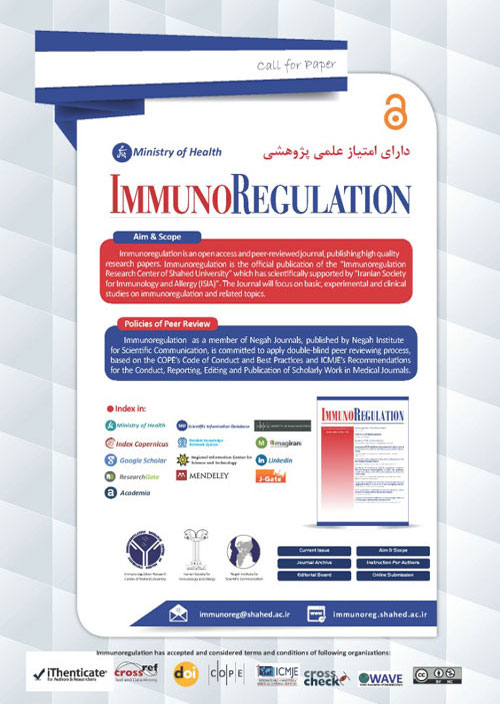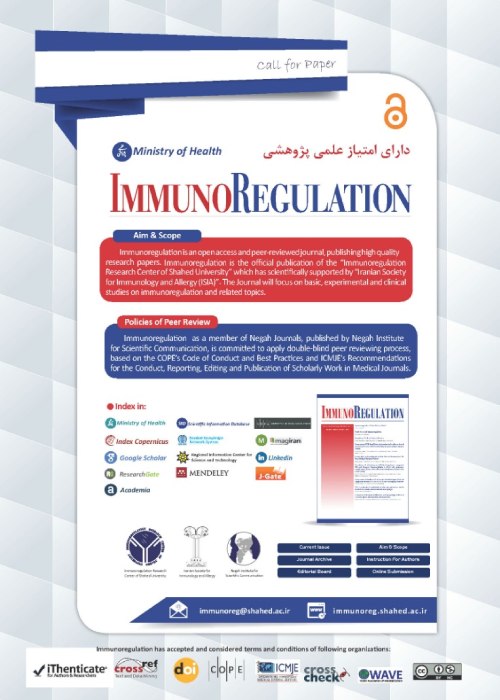فهرست مطالب

Immunoregulation
Volume:4 Issue: 1, Summer 2021
- تاریخ انتشار: 1400/06/21
- تعداد عناوین: 8
-
-
Pages 3-16
Inequality in health and its multiple dimensions is an essential aspect of social injustice. Several studies have shown that mental and physical health in adulthood is not a phenomenon independent of one’s childhood. Those from lower socioeconomic status have higher mortality and shorter life expectancy. Individualism and utilitarianism in social relationships have led to a wide range of social instability, poverty, deprivation, and inequality in societies. In addition to widespread social effects, they have made harmful consequences on the basic vital systems and organs through interference with multiple biological processes. In modern societies, people live in highly stressful situations, and several studies have pointed a strong relationship between the higher prevalence of diseases and social and physiological stresses. Studies of normal and experimental situations also showed their significant effects on the immune response. Accordingly, increased incidence of invasive behaviors has been associated with increased cytokines and immune-cellular activity in animal studies. According to the stimulus type and contact duration, chronic stress influences both innate and acquired immune factors. Stress affects the immune system via activation of the hypothalamus-pituitary-adrenal axis and affects the innate immune agents such as monocytes, macrophages, and proinflammatory cytokines, causing the increase of stress hormones (glucocorticoid-catecholamines). Chronic stress influences the acquired immune components by changing the immune cell population and altering the balance between immune cells and their secreted cytokine levels.
Keywords: Social stress, Inequality, Poverty, Lipofuscin, Safety, Inflammatory cytokines, Pain -
Pages 17-20
Coronavirus Disease 2019 (COVID-19) is one of the most critical health issues in the world. According to the findings, systemic proinflammatory cytokine release is associated with the pathogenesis of cytokine storm, contributing to morbidities and even mortality in patients diagnosed with COVID-19. Among pregnant patients diagnosed with COVID-19, preterm labor is one of the most crucial side effects, with a prevalence of up to 63.8% in some studies. As well as cytokine storm, proinflammatory cytokines are involved in preterm labor. Mesenchymal Stem Cells (MSCs) transplantation has been used in different trials to suppress inflammation in many inflammatory diseases. MSCs have also been successfully applied to treat patients diagnosed with COVID-19, considering the cytokine storm in these patients. So, it is possible to use the transplantation of MSCs derived from the maternal side of the placenta as an autologous product to suppress cytokine storm in critically ill patients diagnosed with COVID-19. The autologous transplantation of MSCs helps to suppress cytokine storm and systemic inflammation. Inhibition of systemic cytokine release could prevent poor outcomes, especially mortality and morbidities in the mentioned patients.
Keywords: Coronavirus Disease 2019 (COVID-19), Inflammation, Cytokine storm, Mesenchymal Stem Cells, Cell therapy -
Immunomodulatory Effects of Origanum vulgare L. and Origanum Majorana L. Ethanolic Extracts in VitroPages 21-32BackgroundMany plants possess therapeutic properties against infectious and non-infectious diseases, including cancer and inflammatory diseases. Plants may have immunomodulatory properties, too. In this study, we evaluated the immunomodulatory effects and toxic properties of ethanolic extract from the Lamiaceae family on macrophage, lymphocyte, and B Cell Leukemia (BCL-1) in vitro.Materials and MethodsPlant samples were purchased, and the ethanolic extract from their leaves was prepared by dissolving them in ethanol (maceration) for 48 hours. The obtained ethanolic extract was dried at room temperature. The normal lymphocytes and macrophages extracted from BALB/c mice and BCL-1 were cultured with different concentrations of the extracts for 24 hours. MTT assay was performed to evaluate proliferation, and Lactic Dehydrogenase (LDH)-based cytotoxicity was measured.ResultsWe found that ethanolic extracts at a concentration of 1 mg/mL significantly increased lymphocyte proliferation (47% by Origanum vulgare and 95% by Origanum majorana compared to the control group). Also, the activity of macrophages increased 35% after O. vulgare administration and 23% after O. majorana administration at a dose of 1 mg/mL. Furthermore, LDH results prove that O. vulgare and O. majorana (1 mg/mL) had no toxic effect on normal lymphocytes and macrophages. The finding of the MTT assay showed that extracts of O. vulgare (with IC50 of 1.04 mg/mL) and O. majorana (with IC50 of 1.6 mg/mL) could significantly suppress the growth of BCL-1.ConclusionThe O. vulgare and O. majorana extract with immunomodulatory effects increased the proliferation and activities of lymphocytes and macrophages in a dose-dependent manner. Also, the tested extracts were showed significant anticancer activity.Keywords: Immunomodulatory, Ethanolic extracts, Origanum vulgare, Origanum majorana, B Cell Leukemia (BCL-1)
-
Pages 33-42Background
Wogonin as a flavonoid compound is known for its anticancer effect through growth control, differentiation, and apoptosis. This study investigates the possible activity of wogonin in inducing cell death of breast tumors MDA-MB231.
Materials and MethodsThe level of cell proliferation was evaluated by MTT assay. Cycle analysis and the apoptotic rate were assessed by flow cytometry. mRNA level of Bax, Bcl-2, p53, and survivin was evaluated by real-time PCR. Western blot was utilized to assert the relative protein expression.
ResultsWogonin inhibits the proliferation of MDA-MB231 over time, and in particular, wogonin can induce the arrest of phase G1 of MDA-MB231 cells. The apoptosis of wogonin was related to a remarkable decrease in Bcl-2 and survivin and an increment in p53 and Bax. Wogonin also significantly elevated the active apoptotic forms of caspase-3, -8, -9. Z-DEVD-FMK, a specific inhibitor of caspase-3, remarkably inhibits cellular apoptosis caused by wogonin. Wogonin suppresses PI3K/Akt phosphorylation and ERK-derived phosphorylation. PD98059, a specific ERK inhibitor, significantly blocked the apoptosis caused by wogonin. Also, LY294002, a specific suppressor of PI3K, remarkably elevates the cellular apoptosis caused by wogonin. Various studies demonstrated that LY294002 not only modulates the expression of the survivin gene alone but also enhances the suppression of the expression of survivin with wogonin.
ConclusionThe apoptotic role of wogonin is observed by the triggering caspases and ERK and is associated with the suppressive pathways of the PI3K/Akt/survivin signal in the MDA-MB231 cells.
Keywords: Wogonin, Apoptosis, Survivin, Breast cancer -
Pages 43-52Background
Synthetic nanoparticles are deemed to improve treatment with the least adverse effects. The effect of Selenium Nanoparticles (SeNPs) was reviewed on various pathogenic disorders. In the present project, the role of SeNPs on macrophage responses was assessed.
Materials and MethodsSeNPs were prepared synthetically by ascorbic acid. Macrophages (MQs) were cultured and treated with SeNPs in combination with bladder tumor lysate and Bacillus Calmette Guerin (BCG). Other experimental groups include SeNPs + tumor lysate + MQs, BCG, BCG+MQs, and MQs. The mRNA levels of interferon-γ and interleukin-10 were evaluated using the real-time PCR method.
ResultsSynthetic selenium nanoparticles combined with the tumor lysate upregulated the mRNA level of interferon-γ after 12 and 24 h treatment. Regarding interleukin-10 expression, there were no remarkable differences in all experimental groups. The maximum effect of synthetic SeNPs was observed after 24 h treatment.
ConclusionThe optimum effect of synthetic SeNPs presents in a treatment-dependent manner.
Keywords: Synthetic selenium nanoparticles, Bacillus Calmette Guerin (BCG) therapy, Bladder tumor lysate, Macrophage response -
Pages 53-60BackgroundHematologic malignancies can be divided into two categories: myeloid and lymphoid, each of which is further divided into acute and chronic. Chronic myeloid diseases consist of Myelodysplasia Syndrome (MDS), Myeloproliferative Neoplasms (MPNs), and a rare group of MDS/MPN. According to genetic studies, the prevalence of some mutations related to cell division is higher in these patients. Given that gene analysis is an available way to diagnose the disease quickly, treat it on time, and help promote effective drugs, this study aims to investigate the frequency of JAK2, BCR-ABL P190, and BCR-ABL P210 mutations in patients with neoplasms who refer to Shahid Mostafa Khomeini Hospital, Tehran, Iran, between March 2017 and September 2020.Materials and MethodsThe blood samples of the patients were analyzed by PCR for the expression of BCR-ABL P190, BCR-ABL P210, and JAK2 genes to investigate any potential relationship between malfunctioned genes and the existing medical condition.ResultsThe mean age of the study patients was 60.5±14.7 years. Of whom 28 (53.8%) were male, and the other 24 (46.2%) were female. Also, 29 patients (55.8%) had Essential Thrombocythemia (ET), 37 patients (71.2%) had at least one of the studied mutations, 21 patients (40.4%) had JAK2 mutation, and 16 patients (31.8%) had BCR-ABL mutation. There was no significant relationship between gender and any of the studied variables. Type of disease had a significant relationship with the studied mutations.ConclusionAll CML cases in this study had at least one of three types of mutations. The type of medical condition was significantly associated with the studied mutations, for example, CML patients had fewer JAK2 and more BCR-ABL gene mutations. gender was not significantly related to any factor in the study. There was no mortality during the study. All the patients were alive, and most of them (88.5%) were in remission.Keywords: Myeloproliferative, Jak2, BCR-ABL P190, BCR-ABL P210, Mutation
-
Pages 61-65BackgroundFinding a sample of healthy tissue is a critical challenge in research studies. Non-pathological Tissue adjacent to the tumor (NAT) specimens is usually used as the control in several studies. However, little is known about the similarity of NAT to healthy tissues. Here, we compared the expression of Matrix Metalloproteinase 2 (MMP-2) and its inhibitor, Tissue Inhibitors of MMP (TIMP)-1 as extracellular matrix remodeling factors in NAT and autopsy lung tissue.Materials and MethodsRNA of 7 NAT and 6 Formalin-Fixed Paraffin-Embedded (FFPE) lung autopsies from healthy people as the control group was extracted, and cDNA was synthesized. The gene expression levels of MMP-2 and TIMP-1 were evaluated by real-time PCR.ResultsThere were no significant differences in the expression of MMP-2, TIMP-1, or their ratio between the two groups.ConclusionThe results showed that NAT could be used as healthy controls in lung tissue studies for MMP-2 and TIMP-1.Keywords: Lung cancer, Autopsy, MMP-2, TIMP-1


